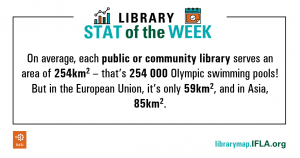 One of the key strengths of libraries – in particular public and community libraries – is the fact that they are local.
One of the key strengths of libraries – in particular public and community libraries – is the fact that they are local.
Being close to the communities they serve gives them a unique potential to understand what people need, and to provide collections and services accordingly.
Of course, ‘closeness’ is about more than just geography, but this does undoubtedly play a role. When a single library needs to service a large area – for example rural or sparsely populated ones – it can be more difficult to ensure support to everyone who lives there. This is a particular concern for people who are disabled or otherwise find it difficult to move around.
Clearly detailed data about the average distance for any given individual to a library requires disaggregated data at the local level.
However, we can start to understand in which countries people may risk being the furthest away from libraries by calculating the average area that any given public or community library serves. We can do this by taking World Bank figures on the surface area of countries, and dividing this by the number of public and community libraries, as reported on IFLA’s Library Map of the World.
This gives us a total figure – for reporting countries – of 254km2 served per library – the equivalent of 254 000 Olympic swimming pools (each pool is 1000m2). There is – as always – variation! At the regional level, the European Union has the highest density of public libraries – one for every 50km2. Asia comes next, with one library for every 85km2.
At the national level, Asia claims both of the top spots, with Macao (one library for every 0.4km2) and Singapore (one every 2km2). Czechia has the densest network in Europe (one library for every 13km2), Moldova in non-EU Europe (one every 25km2), Réunion in Africa (one every 31km2), St Lucia in Latin America and the Caribbean (one every 32km2), Bahrain in MENA (one every 65km2), and New Zealand in Oceania (one every 631km2).
Clearly, as highlighted before, these figures are averages, and a more detailed understanding of how far people need to travel to get to a library requires more disaggregated data. Next week, we’ll move a step closer by looking at how population density and library density are related.
Find out more on the Library Map of the World, where you can download key library data in order to carry out your own analysis! See our other Library Stats of the Week! We are happy to share the data that supported this analysis on request.